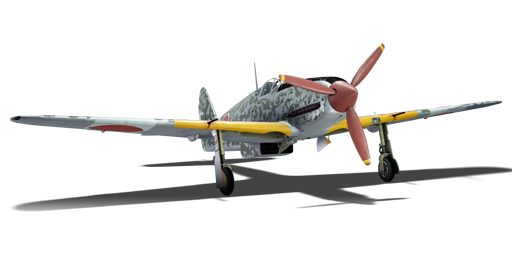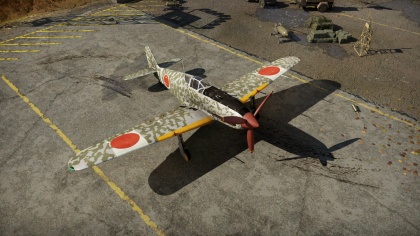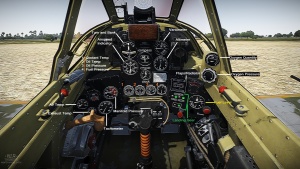Ki-61-I hei
Contents
| This page is about the Japanese fighter Ki-61-I hei. For other versions, see Ki-61 (Family). |
Description
The Ki-61-I hei Hien is a rank IV Japanese fighter
with a battle rating of 5.3 (AB), 4.7 (RB), and 4.0 (SB). It has been in the game since the start of the Open Beta Test prior to Update 1.27.
The "Hei" modification of the Ki-61 still retains the above average manoeuvrability, common to the Japanese aviation tree. However, the Hei Hien has some faults - its top speed is only 20 km/h higher than that of the early "Zeroes". Its climb rate is enough for its role, and it retains energy fairly well. While its acceleration holds itself pretty well, Its top speeds are not on par with other aircraft making it similar to the German Bf 109 G-6. Its guns are also a hit and miss - it is equipped with the deadly MG 151 20 mm cannons, and it can also equip German belts with minengeshcoß shells. However, the Japanese 12.7s are lower velocity and a bit on the weak side. The Hien's ammo count is average, albeit not as much as American aircraft. One thing to be noted is that the landing flaps are very effective and will slow you down even if you use WEP. That said, use them when you are trying to make somebody on your six overshoot you.
The Hei Hien's armament is flexible, as it is able to equip multiple kinds of bombs. With accuracy and shot placement, the large ammunition pool can work to your advantage. Equipping the air targets belt for the MG 151 cannons is the best choice for air combat. It features a high degree of minengeschoß shells, specially made German HE shells with thin walls. There is no 20 mm cannon shell in the game with more high explosive than the minengeschoß. As for the 12.7s, Stealth or Air target belts are your best bet. The best choice of bomb loadout is the 250 kg bombs due to the lack of precision needed. A pilot can miss a direct hit on a pillbox and still destroy it.
General info
Flight performance
Describe how the aircraft behaves in the air. Speed, manoeuvrability, acceleration and allowable loads - these are the most important characteristics of the vehicle.
| Characteristics | |||||||
|---|---|---|---|---|---|---|---|
| Stock | |||||||
| Max Speed (km/h at 6,000 m) |
Max altitude (meters) |
Turn time (seconds) |
Rate of climb (meters/second) |
Take-off run (meters) | |||
| AB | RB | AB | RB | AB | RB | ||
| 572 | 556 | 10300 | 21.9 | 22.5 | 7.1 | 7.1 | 380 |
| Upgraded | |||||||
| Max Speed (km/h at 6,000 m) |
Max altitude (meters) |
Turn time (seconds) |
Rate of climb (meters/second) |
Take-off run (meters) | |||
| AB | RB | AB | RB | AB | RB | ||
| 613 | 591 | 10300 | 20.3 | 21.0 | 13.7 | 10 | 380 |
Details
| Features | ||||
|---|---|---|---|---|
| Combat flaps | Take-off flaps | Landing flaps | Air brakes | Arrestor gear |
| ✓ | ✓ | ✓ | X | X |
| Limits | ||||
|---|---|---|---|---|
| Wing-break speed (km/h) |
Gear limit (km/h) |
Combat flaps (km/h) |
Max Static G | |
| + | - | |||
| 500 | ~10 | ~7 | ||
| Optimal velocities | |||
|---|---|---|---|
| Ailerons (km/h) |
Rudder (km/h) |
Elevators (km/h) |
Radiator (km/h) |
| < 360 | < 350 | < 460 | > 312 |
| Compressor (RB/SB) | ||
|---|---|---|
| Setting 1 | ||
| Optimal altitude | 100% Engine power | WEP Engine power |
| 3,550 m | 1,100 hp | 1,232 hp |
Survivability and armour
- 13 mm Steel plate behind the pilot
Armaments
Offensive armament
The Ki-61-I hei is armed with:
- 2 x 20 mm MG 151/20 cannons, wing-mounted (150 rpg = 300 total)
- 2 x 12.7 mm Ho-103 army machine guns, nose-mounted (400 rpg = 800 total)
Suspended armament
The Ki-61-I hei can be outfitted with the following ordnance:
- Without load
- 2 x 50 kg Army Type 94 GPHE bombs (100 kg total)
- 2 x 100 kg Army Type 94 GPHE bombs (200 kg total)
- 2 x 250 kg Army Type 92 GPHE bombs (500 kg total)
Usage in battles
Instead of simply turn fighting the Ki-61 is very good at energy fighting, or "boom and zoom". Once at a high altitude the Hien pilot may choose to dive lower to attack an enemy. If the enemy is not destroyed on the first pass, it is recommended to climb sharply and gain altitude. By doing this, the Hien sets itself up for another attack while not being in the range of the enemy's guns.
The Hei Hien is best utilised as a multi-purpose fighter. Although proficient at energy fighting, the Ki-61 is also generally good at standard manoeuvres. It may lose turn fights with some enemy aircraft like the Spitfire Mk Vb/trop, but nonetheless it can still be used in multiple roles. The Hien is your standard "jack of all trades". It's not incredibly good at anything it does but is instead even across the board. This allows the Hien pilot to choose what role he or she wants to play in the battle. One could play the reserved, high flying energy fighter, or the aggressive low flying dog-fighter. The Ki-61 allows these choices.
If caught in a sticky situation, the Hien pilot may choose to do several things. Depending on your altitude, executing rolling scissors or an overshoot may be a valid tactic. Try to make the enemy pilot feel pressured to disengage. Depending on the enemy's aircraft, use your speed to your advantage and try to get away. The surest tactic would be communicating with teammates to ensure your assailant's death. Once tailed, the Hien pilot can "set up" an enemy by nosing up about 70 degrees so the entirety of the enemy plane is shown. At this stage, ideally, your teammate is arriving to save the day. In Realistic battles, if your team is made up of A6Ms it may also be beneficial to fly to them and start turn fighting.
Manual Engine Control
| MEC elements | ||||||
|---|---|---|---|---|---|---|
| Mixer | Pitch | Radiator | Supercharger | Turbocharger | ||
| Oil | Water | Type | ||||
| Not controllable | Controllable Not auto controlled |
Controllable Not auto controlled |
Controllable Not auto controlled |
Separate | Not controllable 1 gear |
Not controllable |
Modules
| Tier | Flight performance | Survivability | Weaponry | ||
|---|---|---|---|---|---|
| I | Fuselage repair | Radiator | Offensive 12 mm | 7 in (mod20) | |
| II | Compressor | Airframe | New 12 mm MGs | 10 in (mod24) | |
| III | Wings repair | Engine | Offensive 20 mm | 12 in (mod30) | |
| IV | Engine injection | Cover | New 20 mm cannons | ||
- Unlocking the "Offensive 20 mm" module should be a Hien pilot's first concern. The stock MG 151 belts aren't very good in a general sense, but the "Air targets" belt is. The "New 12.7 mm MGs" and "New 20 mm cannons" modules can also be helpful as they allow for longer periods of firing. Unlocking the bomb modules can help on most maps, no matter the game mode. Destroying some extra ground units can't hurt a team's victory chances. After researching the 20 mm belts try to unlock the performance modules.
Pros and cons
Pros:
- Above average manoeuvrability
- Good diving capabilities
- Equipped with German MG 151 cannons, firing minengeschoß shells
- Self-sealing fuel tanks
- Relatively good high altitude capabilities (compared to other Japanese tier III planes)
- High ammunition count
- Above average energy retention
- Able to equip bombs
Cons:
- Little armour
- Generally slow
- Wobbles in unexpected turns
- The aircraft's battle rating is high for its performance
- Vulnerable to fires
History
The Ki-61 was first put into service in with a special training unit, the 23rd Chutai, and entered combat for first time in early 1943, during the New Guinea campaign. The Hiens were sent into a difficult theatre where jungles and adverse weather conditions coupled with a lack of spare parts quickly made short work of the Japanese fighters. Nonetheless, the Hien proved to be a worthy adversary and it even outclassed the P-40. Towards the end of the war, Ki-61s were relied upon heavily to defend the Japanese mainland from B-29 attacks. Some pilots used ramming attacks to down the Superfortresses. Soon, entire "special attack squadrons" were formed for the sole purpose of ramming B-29s.
The Ki-61-I hei model utilised imported German Mauser MG 151 20 mm cannons, placed in the wings. 800 of these weapons along with ammunition were sent to Japan via submarine in August of 1943.
In-game description
A lightweight multipurpose fighter plane, the Ki-61 Hien ("Swallow") was well-armed and well-armored.
From the very beginning, the makers of the Ki-61 concerned themselves with protecting the fuel tanks and the pilot. The light multipurpose fighter was an effective answer to "hit-and-run" fighters, thanks to its survivability and high diving speed.
The Ki-61 had a Kawasaki Ha-40 liquid-cooled inverted V12 engine, a licensed copy of the DB 601A, capable of 1175 hp.
A prototype was ready in 1941, and by the next year the first production models were manufactured and the Ki-61 entered service.
To strengthen armament in the Ki-61-I, instead wing-mounted machine guns of the previous models Ki-61-1-Co and -Otsu was established by German's 20-mm cannons MG 151/20, which in the amount of 800 units in august 1943 were taken to Japan by submarines.
All in all, 3,078 Ki-61 fighters (of various types) were produced.
Media
Excellent additions to the article would be video guides, screenshots from the game, and photos.
See also
Links to the articles on the War Thunder Wiki that you think will be useful for the reader, for example:
- reference to the series of the aircraft;
- links to approximate analogues of other nations and research trees.
External links
Paste links to sources and external resources, such as:
- topic on the official game forum;
- encyclopedia page on the aircraft;
- other literature.
| Japan fighters | |
|---|---|
| Navy | |
| Carrier-based fighter | |
| A5M | A5M4 · Hagiri's A5M4 |
| A6M | A6M2 mod. 11 · A6M2 · A6M3 · A6M3 mod. 22 · A6M3 mod. 22Ko · A6M5 · A6M5 Ko · A6M5 otsu · A6M5 Hei · A6M6c |
| A7He | A7He1* |
| A7M | A7M1 (NK9H) · A7M2 |
| Land-based Fighter | |
| J2M | J2M2 · J2M3 · J2M4 Kai · J2M5 · J2M5 (30 mm) |
| J6K | J6K1 |
| J7W | J7W1 |
| N1K-J | N1K1-Ja · N1K2-J · N1K2-Ja |
| Fighter seaplane | |
| N1K | N1K1 |
| A6M-N | A6M2-N |
| Army | |
| Ki-10 | Ki-10-I · Ki-10-I C · Ki-10-II · Ki-10-II C |
| Ki-27 | Ki-27 otsu · Ki-27 otsu Tachiarai |
| Ki-43 | Ki-43-I · Ki-43-II · Ki-43-III otsu |
| Ki-44 | Ki-44-I · Ki-44-I 34 · Ki-44-II otsu · Ki-44-II hei |
| Ki-61 | Ki-61-I ko · Ki-61-I otsu · Ki-61-I hei · Tada's Ki-61-I hei · Ki-61-I tei · Ki-61-II Otsu Kai |
| Ki-84 | Ki-84 ko · Ki-84 otsu · Ki-84 hei |
| Ki-87 | Ki-87 |
| Ki-94 | Ki-94-II |
| Ki-100 | Ki-100 · Ki-100-II |
| Other countries | ▅F4U-1A · ▅P-51C-11-NT · ▅Bf 109 E-7 · ▅Fw 190 A-5 |
| *Imported designation of the He 112 (A6M was in development - A7M would take A7 designation after the cancelation of the A7He) | |






